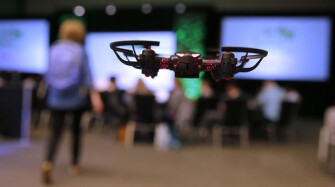
Drones have been drifting into K-12 classroom lesson for years. Now teachers are receiving more specific guidance than ever before on how to use the aerial devices in ways that will bring a payoff for students.
The guidance is coming from organizations like the International Society for Technology in Education, which recently published advice for educators on the subject, and the National Science Teachers Association, which at its conferences has offered educators guidance on how to use drones in classes.
ISTE’s blueprint, “Drones in Education: Let Your Students’ Imaginations Soar,” argues for integrating drones into instruction across multiple subjects. The science teachers’ group is staging professional development activities to help teachers come up with specific ideas for lessons crafted around the aerial devices.
One of the authors of the ISTE book, Laura Zieger, argued that lessons involving drones can not only expose students to cutting-edge technology, but also prepare them for potential careers in science-focused fields.
Students should be exposed to technology drones “as early as possible throughout the curriculum, just as they are exposed to writing tools and presentation resources to better situate them for their future careers,” argued Zieger, the chairperson and a professor in the educational technology department at New Jersey City University.
Teachers have found a variety of ways to integrate drones across multiple subjects. Zieger has seen Spanish teachers use drones to help students understand vocabulary directions and engineering teachers ask students to build their own aerial devices to learn the physics that govern flight.
“And we’ve already seen some of the amazing uses in photography and the arts as well,” she said. Social studies teachers can use drones to help students visualize longitude and latitude. Even physical education teachers can use the devices to help students pace their running and for videotaping sports events.
Hewing to Regulations, Safety
Some teachers are wary of using drones because of worries about federal regulations on the devices set by the Federal Aviation Administration, as well as cost and safety concerns.
And many teachers mistakenly believe they can only use drones inside a gym or classroom due to regulations set by the FAA, Zieger said. But in a memorandum issued last year, the FAA said that students can use drones for educational and research purposes. That means school districts do not need any special exemption or authorization to use the devices, but they still must comply with the federal regulations, such as the requirement that all drones between 0.55 and 55 pounds must have registration with the agency, Zieger explained.
Some small-size drones cost as little as $40. But school districts may also find that larger sized drones with more capabilities cost around $500 dollars, said Chris Carnahan, another author of the ISTE guide who is also the doctoral program coordinator and an assistant professor in the educational technology department at New Jersey City University.
Despite their increasing popularity in schools and among the public, schools need to understand best practices for using them, which unfortunately, “many districts tend to ignore until a safety incident occurs,” said Kenneth Roy, chief safety compliance adviser for NSTA.
Roy noted that NSTA has put forward guidance for teachers on how to use aerial devices for instructional purposes with safety in mind. One of the guide’s recommendations is that teachers either tether the drones, attach guards to the blades and require students to wear eye protection.
Some critics may question the value of introducing students to a technology that in some contexts is associated military combat. But Roy pointed out that history of drones’ use is more nuanced than many acknowledge.
“Drones themselves aren’t anything that new,” Roy said. Unmanned aircraft systems, he said, have appeared since the American Civil War.
“What is new, however, is how easily the public can purchase them,” he said. “Sometimes adults become blinded by these rare cases, but children come up with great ideas--they’re free spirited and have inquiring minds. They have the creativity of finding different uses with these technologies. As teachers, it’s important to make a well-developed plan on how to introduce these topics and objects to students.”
Roy said bringing in the history of drones offers good lessons for students about the technology. In talking about the evolution of the devices, teachers can bring up their peacetime application in delivery, photography, videography and other technological advances.
The guide’s authors wanted to come up with a practical guide for teachers who want to use innovative technologies in their lessons.
“We tried to keep the content at an entry level - nothing about the high level robotics,” Carnahan said. “Through the book, we encourage teachers to be leaders in something that will continue to expand and apply to real world applications.”
Photo: A drone flies through the SXSWedu playground in Austin, Texas, earlier this year. Erich Schlegel for Education Week.
See also:

